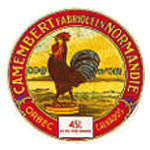Description
The Camembert de Normandie PDO is a soft-paste cheese with a flowered rind covered by a thin white layer. It is produced only with raw milk from cows of Norman breed partly (50% in 2020) which crop for more than six months a year.
Production Area
The production area of Camembert de Normandie PDO covers partly the departments of Calvados, Manche, Orne and a a little part of Eure in Upper and Lower-Normandy.
Production Method
Production method: the milk used to produce it must not undergo a temperature higher than 40°C. A day after milking, the milk is curdled and put into cylindrical cheese moulds with a suitable spoon. Every mould will contain five spoons of curd. The passage of the spoon must take place every 40 minutes to ensure the best spontaneous (natural) dripping. Then, the cheeses are turned out, dry salted and pulverized with moulds, Penicillium candidum. Its minimum ripening lasts 22 days, but to achieve a more refined cheese, 30-35 days are necessary. Ripening takes place in rooms with a temperature between 10°C and 18°C, before being packed in wooden boxes. Then, the cheese can be stored in fresher cellars (between 8°C and 12°C) to continue the ripening.
Appearance and Flavour
Appearance and flavour: Camembert de Normandie PDO has a white rind with red veins and spots and a smooth, dense and soft paste, which is ivory colour tending to straw yellow. The half-refined type shows in the centre of the paste a white hazel of about 2-3 mm. It is a creamy cheese, with a buttery flavour, slightly salted and fruity. It must have a slight mould scent.
History
The origin of Camembert de Normandie PDO goes back to the French Revolution. It was produced for the first time at Vimoutiers, in the Camembert municipal area, by a farmer called Marie Harel, who, following the suggestions of a priest, created the process to make the Camembert. This production was passed on, generation by generation. The process was repeated by her daughter Marie, and her sons, still in the Camembert village. Napoleon, after different years, went to Camembert and tasted the cheese which he much appreciated and decided to give it a name: the name of its production village.
Gastronomy
Camembert de Normandie PDO must be conserved in a fresh place (7-8°C) or in the refrigerator to maintain its organoleptic features. It is sold into characteristic boxes made in poplar wood which enable a good aeration and must stay at room temperature for about an hour before tasting. It can be eaten with bread, accompanied by a citrus or soft fruits jams. It is used to season and enrich flans and cheese dishes and is very good wrapped into breadcrumbs. As regards the combination with wines, the choice is vast and the most traditional people like to taste it with a Normand cider PDO or a simple Cider Brut.
Marketing
The product is sold as Camembert de Normandie PDO. It is marketed fresh, both refined and midrefined, whole.
Distinctive Features
The unique characteristics of Camembert de Normandie PDO are due to the milk used and the cheese-making techniques. The milk is produced by Norman breed cows, selected over centuries, which are raised in large pasture areas for six months a year at least. During cheese making, some moulds, which were discovered around the end of the 19th century, are able to give to the cheese a unique aroma.







